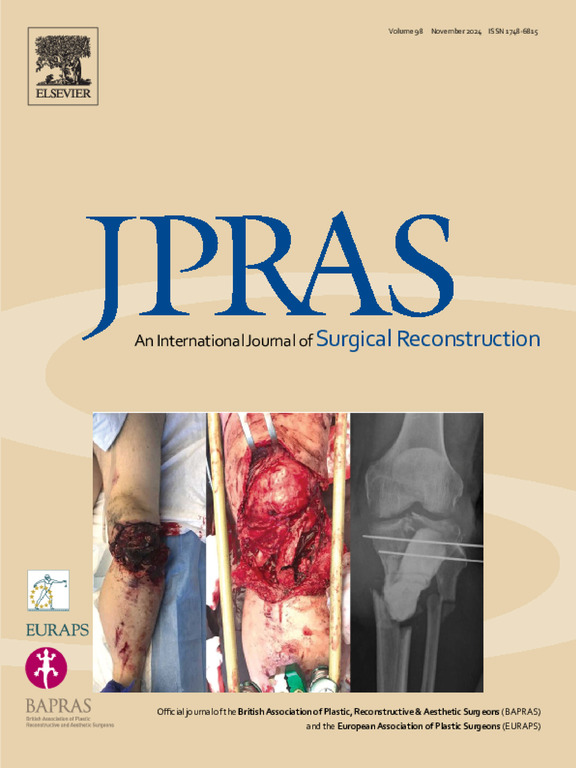The influence of cardiovascular disease on duration of admission after DIEP flap breast reconstruction: A retrospective cohort study
IF 2.4
3区 医学
Q2 SURGERY
Journal of Plastic Reconstructive and Aesthetic Surgery
Pub Date : 2025-07-31
DOI:10.1016/j.bjps.2025.07.031
引用次数: 0
Abstract
Objectives
Deep Inferior Epigastric Perforator (DIEP) flaps are a preferred type of autologous breast reconstruction because of their relatively low rate of donor site complications. Comorbidities, such as cardiovascular disease (CVD) and hypertension (HTN), influence the rate of post-operative complications, leading to increased length of stay (LOS). The Nationwide Readmission Database (NRD) compiles readmission and LOS data in the USA. We aim to investigate the relationship between CVD and cardiovascular risk factors and the LOS after DIEP flap.
Methods
The NRD was queried from 2016 to 2020 using ICD-10 codes for DIEP flaps. The resulting dataset was analyzed for congestive heart failure (CHF), hypertension, obesity and diabetes. Multivariate regression analyses were performed to evaluate the influence of CVD on LOS.
Results
A total of 23,319 cases were identified; the average LOS without comorbidities was 4.15 days. Complicated HTN increased LOS by 1.17 days while uncomplicated HTN, CHF, complicated diabetes, morbid- and moderate obesity all significantly increased the length of stay by 0.09, 0.64, 0.40, 0.29 and 0.24 days, respectively (P<0.05). Out of 20,423 patients, 872 were readmitted within 90 days (4.3%). Main reasons for readmission were infection (83.8%), vascular complications (12.7%) and seroma (8.3%). Flap failure occurred 6 times.
Conclusion
Results show that CVD increased the LOS after DIEP flap, with complicated HTN increasing LOS most by 1.17 days. This is clinically relevant due to the rising cost of healthcare and the shortage of healthcare workers.
心血管疾病对DIEP皮瓣乳房重建术后住院时间的影响:一项回顾性队列研究
目的腹壁深下穿支(DIEP)皮瓣因其较低的供区并发症发生率而成为自体乳房再造术的首选。合并症,如心血管疾病(CVD)和高血压(HTN),影响术后并发症的发生率,导致住院时间(LOS)增加。全国再入院数据库(NRD)汇编了美国的再入院和LOS数据。我们的目的是探讨心血管疾病和心血管危险因素与DIEP皮瓣术后LOS的关系。方法采用ICD-10编码查询2016 - 2020年DIEP皮瓣的NRD。结果数据集分析了充血性心力衰竭(CHF)、高血压、肥胖和糖尿病。采用多变量回归分析评价心血管疾病对LOS的影响。结果共检出病例23319例;无合并症的平均LOS为4.15天。合并HTN使住院时间增加1.17天,而未合并HTN、CHF、合并糖尿病、病态肥胖和中度肥胖患者的住院时间分别显著增加0.09、0.64、0.40、0.29和0.24天(p < 0.05)。在20423名患者中,872名患者在90天内再次入院(4.3%)。再入院原因主要为感染(83.8%)、血管并发症(12.7%)和血肿(8.3%)。皮瓣失败6次。结论CVD使DIEP皮瓣术后LOS增加,其中合并HTN使LOS增加最多,增加时间为1.17 d。由于医疗保健费用的上升和医疗工作者的短缺,这是临床相关的。
本文章由计算机程序翻译,如有差异,请以英文原文为准。
求助全文
约1分钟内获得全文
求助全文
来源期刊
CiteScore
3.10
自引率
11.10%
发文量
578
审稿时长
3.5 months
期刊介绍:
JPRAS An International Journal of Surgical Reconstruction is one of the world''s leading international journals, covering all the reconstructive and aesthetic aspects of plastic surgery.
The journal presents the latest surgical procedures with audit and outcome studies of new and established techniques in plastic surgery including: cleft lip and palate and other heads and neck surgery, hand surgery, lower limb trauma, burns, skin cancer, breast surgery and aesthetic surgery.

 求助内容:
求助内容: 应助结果提醒方式:
应助结果提醒方式:


